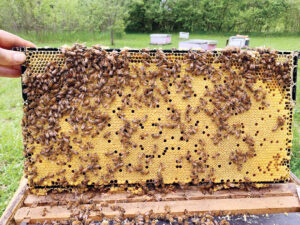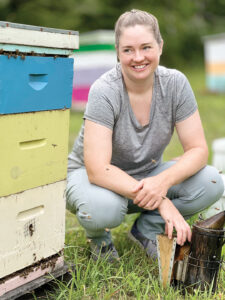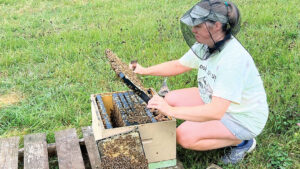What’s all the buzz?
12/6/2023 When Ellen Bell started beekeeping with two hives in her backyard, she never imagined she’d have nearly 6 million bees 10 years later.
When Ellen Bell started beekeeping with two hives in her backyard, she never imagined she’d have nearly 6 million bees 10 years later.
Bell is a beekeeper at Bell Farm, located in Runnels. She and her family lived in Altoona yet longed for a country home to establish a garden and raise chickens for meat and eggs. She attended a beekeeping class, ordering two hives. As the farm progressed, she kept coming back to the bees.
“It really resonated with me,” she said. “The creatures are so fascinating. There’s so much to learn.”
Today she has about 120 beehives. Each hive has between 30,000 to 50,000 bees. Her task is to take the hives and divide them, selling the splits to beekeepers.
When working with the bees, she says she has to “be on her toes.” A productive queen bee lays the eggs, and bee offsprings are all hers. Once the hive gets large enough, the bees begin to reproduce. Reproduction takes place through swarming. The hive splits, thus creating a new queen and a new colony.
 “If the swarms aren’t caught, they’ll find their own home in a hollow tree,” she said.
“If the swarms aren’t caught, they’ll find their own home in a hollow tree,” she said.
Not all bees are angry, buzzing and stinging.
“Each hive has a temperament. The bees have their own personality,” she said. “It’s like dogs with their personalities. Some hives are more defensive, and some don’t even know you’re there. Others — from 5 feet away — come out, buzzing, saying, ‘Get away from here!’ ”
In addition to temperament, Bell says bees are attuned to the beekeeper.
“They sense if you’re nervous. I always err on the side of caution.”
Bell often dons a beekeeping veil and gets stung occasionally.
“With all the bees and hives, I’ve been stung maybe five times,” she recalls. “It depends on the day. On a nice sunny day, they are in a good mood. When it’s cloudy, they aren’t in a good mood.”
The bees’ personalities come from the parents. Bell is focused on raising a queen with good genetics and a gentle hive.
“It’s no fun to work with an angry hive,” she said. “People want a good hive.”
 The bees build honeycombs on Langstroth frames. When ready, Bell lifts the frames and extracts the honey from the combs. In Iowa, they collect honey and wax once a year.
The bees build honeycombs on Langstroth frames. When ready, Bell lifts the frames and extracts the honey from the combs. In Iowa, they collect honey and wax once a year.
Bell says it’s a misconception that bees use only flowers on the ground to collect nectar.
“Nectar comes from the trees in bloom,” she said. “One mature tree is good enough for all of the bees.”
When the temperature drops below 50 degrees, bees cluster for warmth and generate heat, maintaining a temperature of 85 to 95 degrees. The cluster is the size of a basketball.
“We’ve put a thermal camera on them to show how nice and cozy it is.”
Bell likes the bees, as it’s a close connection to nature.
“When I open up the hive, I love the smell, the sound. It’s very grounding to me. It’s very special caring for these creatures. We have no control over them but work with them to provide our needs,” she reflects. “They reward us with honey and wax.”
Bell hosts beekeeping classes and provides beekeeping resources. For more information, visit www.iowabees.com. ♦





















